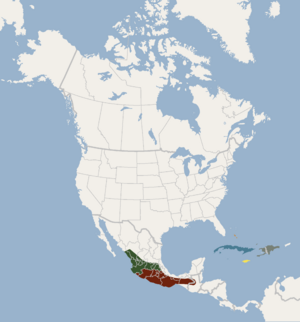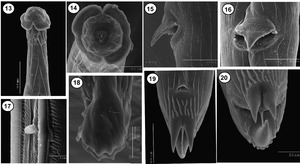Waterhouse's leaf-nosed bat facts for kids
Quick facts for kids Waterhouse's leaf-nosed bat |
|
|---|---|
| Conservation status | |
| Scientific classification | |
| Genus: |
Macrotus
|
| Species: |
waterhousii
|
 |
|
The Waterhouse's leaf-nosed bat (Macrotus waterhousii) is a type of bat with big ears. It belongs to the Phyllostomidae family, which includes many different kinds of bats. You can find these bats in the Greater Antilles, which are islands like the Cayman Islands, Cuba, Hispaniola (where the Dominican Republic and Haiti are), and Jamaica. They are not found in Puerto Rico. These bats also live in Mexico, from the state of Sonora down to Hidalgo, and further south into Guatemala.
Contents
Bat Behavior: How They Live
Waterhouse's leaf-nosed bats usually sleep during the day in caves. They also sometimes make their homes in old mines or even in buildings. These bats are insectivores, which means they mostly eat insects. Their favorite snacks are moths (from the order Lepidoptera) and crickets or grasshoppers (from the order Orthoptera).
Unlike some other bats, these bats do not need their sleeping spots to be completely dark. You might find them near the entrance of a cave, about 10 to 30 meters inside. They can even be in buildings that have some light. While they can be found in groups, they usually do not touch each other directly. They are not as social as some other bat species. These bats typically leave their roosts to hunt about 30 minutes after the sun goes down.
Reproduction and Life Cycle
When female Waterhouse's leaf-nosed bats are pregnant, something interesting happens. The baby bat's development seems to slow down for a while. This is called "delayed development." Scientists think this delay might be controlled by a special hormone in the mother's body.
During the first two parts of the pregnancy, the levels of this hormone are quite low. But in the last part of the pregnancy, and when the mother is feeding her baby, the hormone levels more than double. This increase in the hormone seems to cause the baby bat to grow much faster during that final stage. Most of the baby's growth happens in this last period of pregnancy.
Echolocation: How Bats Find Food
Like many bats, Waterhouse's leaf-nosed bats use echolocation to find their prey. This means they send out sounds and listen for the echoes that bounce back. These bats use a special kind of echolocation call. It is a low-intensity, wide-ranging sound that helps them search for food.
The highest sound frequency they make is about 73.65 kilohertz (kHz). The lowest is around 46.19 kHz. This creates a wide range of sounds, about 27.46 kHz wide. Each call can last from about 1 to 3 seconds. Besides echolocation, these bats can also hear the sounds made by their prey. This helps them find insects even in places with lots of trees or obstacles. When a bat gets closer to its prey, the frequency of its echolocation calls gets lower.
Parasites

The Waterhouse's leaf-nosed bat can have tiny organisms called nematodes living inside them. One specific type of nematode, named Torrestrongylus tetradorsalis, was discovered in 2015. This parasite lives in the small intestine of the bats. Scientists found these parasites in bats from Central Mexico, specifically in the Sierra de Huautla Biosphere Reserve in the state of Morelos.
Images for kids



